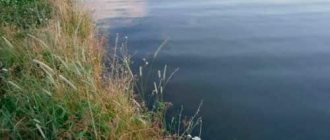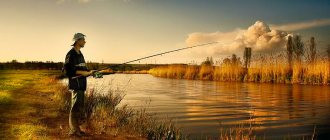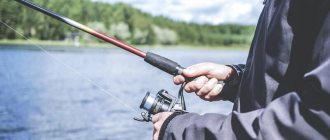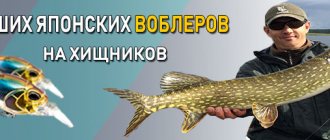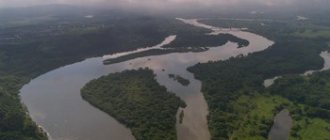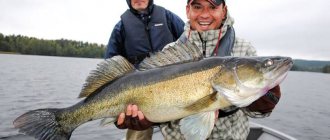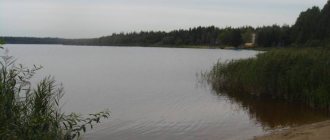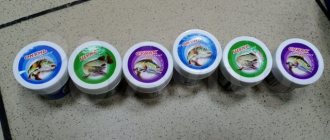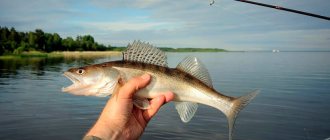Spinning fishing on small rivers and streams is popular due to the prevalence of such reservoirs. All cities in Russia have at least one similar river nearby. When going with a spinning rod along small rivers, it is important to take into account that fishing on them differs from large reservoirs, which leaves an imprint on fishing. One of the features is the need to use small baits, since large specimens are rarely found here, and for small baits it is necessary to use ultralight or light rods.
Features of fishing on small rivers
Content
Spinning fishing on small rivers must take into account the basic rules:
- It is advisable to use fine groundbait in combination with small bait. The reason is not only the size of the average individuals, but also the susceptibility of such reservoirs to active pressure from fishermen. An interesting feature is that a smaller bait is many times more effective than a larger one;
- Due to the small width of the stream, it is better for the spinning angler to use short rods; there is no need for long options, this will only cause inconvenience. It is convenient to fish with an ultralight fishing rod about 2-2.4 m long;
- The melting of ice and warming up of the reservoir occurs much faster, that is, the inhabitants wake up from sleep earlier than in large rivers. Here the season not only begins earlier, but also ends, since the cooling of the water also accelerates;
If during a flood the river connects with large bodies of water, then large individuals may be caught in the river
- The small food supply among the inhabitants of reservoirs causes the frequent capture of small or medium-sized individuals. Trophy specimens come across only to very lucky anglers. More often, large individuals are found in a reservoir if, during a flood, the river connects with large reservoirs;
- Fishermen often go to the reservoir, which causes the absence of a large number of fish. The most compacted rivers are close to the city, as they can be reached by bus. In compacted reservoirs, fish respond well to standard baits for fishing or, on the contrary, avoid them;
- if the promising site is located in a forest, there will be an abundance of snags or many overhanging tree branches at the bottom. This is a good place for fish, as they find shelter in the snags, but the fisherman will need high casting accuracy. We recommend using gear that can be easily replaced in case of a snag. Be sure to use thin fishing line for leashes; you can always tear them off and save the main line;
- Basically, the feeder is not effective, since the depth of the reservoir does not allow the tackle to be lowered deeply. If there are holes at the bottom, bottom gear will be appropriate in them;
- An important feature of shallow rivers is the ability to see prey underwater, but we remember that the fish also sees the fisherman, so camouflage is extremely appropriate.
Fishing spots on the shallows of a small river
In our company of fishermen, when fishing in the summer, the boundaries of the shallows of a small river (see photo) have always been considered promising places for catching predatory fish with bait and other live bait gear.
In the summer, in the sandy shallows of small rivers you can find fish feeding on the current: gudgeon, dace, ide, chub, asp. At certain moments, perch and pike perch drive fry into the shallows. The boundaries of sandbanks are considered good places for summer pike fishing.
In the photo above, the boundary of the weak and fast flow of a small river is clearly visible - the place of the most promising fishing in the summer with live bait gear, where there may be a concentration of “white” fish descending along the riffle.
It is better to install powerful fishing rods with nichrome leashes sliding along the main line in the place shown in the photo on the right, where the current of a small river swirls.
Gear for fishing on small rivers
On small rivers, be sure to take a spinning rod of short length, otherwise you are guaranteed to constantly get caught on branches, creating unnecessary noise and difficulty casting. Experienced fishermen recommend taking models about two meters; the scope of such gear allows for more possibilities and a lower risk of breakage or hooking of the gear. A two-meter spinning rod is enough to fish the center of the river, and usually it is enough to cast bait to the opposite bank.
Read more
Telescopic spinning rods Mikado
Spinning rods of short length are used on small rivers
A light spinning rod for small rivers is the most convenient and versatile option, as it allows you to hunt almost all fish in the river. When choosing gear, it is better to take one with a test weight of up to 20 g. There are also fans of ultralight, their preferred test rod is up to 5 g. A classic spinning rod does not require special rods, but when installing feeders, you will have to take options with a larger test.
The best action in such conditions is super-fast or fast, with their help it is easier to carry out a variety of postings of any baits. Their additional advantage is high casting accuracy, this is especially important due to the numerous obstacles in small bodies of water. The disadvantage is that it is somewhat difficult to catch prey in comparison with slow and medium formations, but this is a forced sacrifice.
The design of the handle is an important parameter of the fishing rod; in small bodies of water it is convenient to use a short monolithic handle. A blank like this makes it easier to cast with one hand. Ultralight fishing rods are often designed with a spaced handle; this is done to reduce the weight of the structure; they are suitable for our purposes.
If you plan to fish with a jig, we recommend using a special spinning rod - area fishing, originally intended for fishing in paid reservoirs. Alternative options are trout fishing rods adapted for fishing on fast rivers. The peculiarities of using jigs determine the need for specific fishing techniques and tactics. We recommend taking these rods up to two meters in length with 3 g of dough and a slow action.
For reels, we can use multiplier models, but inertialess options are easier for a novice fisherman to master and, in general, they are more convenient to use. Multipliers are suitable for testing rods from 10 g, as they provide better sensitivity and control of the equipment. Coils of sizes 1000 and 2000 are comfortable for ultralight, and 2000-3000 are suitable for light, although 4000 are sometimes used, but for specific tasks.
Regarding float and spinning light tackle for fishing on streams, we can choose budget options; their reliability is acceptable for the task at hand. When fishing with high-quality models, ultralight rods and reels will be expensive, and Chinese options lead to frequent breakdowns.
Superfast or fast action is best in such conditions
How to fish in ponds
- VK
Almost all of us at one time or another have to fish in ponds - large, small, clean, dirty, teeming with fish or almost without fish. Today we will not consider fishing in draw ponds and large, even huge ponds, which in their specificity are close to lakes. Let's turn to the most ordinary ponds, which many anglers treat somewhat dismissively and, accordingly, do not take fishing seriously.
This category of reservoirs is headed by flowing, not too small and not too shallow ponds that do not experience winter freezes. They can be located either in populated areas or on their edge, or away from housing, have clean or wooded banks (especially in the upper reaches) and a decent depth along the riverbed and at the dam.
Their typical species composition is pike, perch, roach, perch, fairly large crucian carp, sometimes tench, carp, and bream. Carp, as a rule, end up here by chance from breeding farms.
There are three possible approaches to fishing in such ponds:
- arm yourself with spinning equipment and go after a predator (as an option, catch a predator with live bait);
- set up a light float rod and go after roach and perch, also keeping in mind crucian carp and tench (bream);
- focus on carp, which are usually few in number, large and have become wise to elude anglers for many years.
Light spinning
The most common trophies of spinning anglers in ponds are medium-sized perch and pike up to a kilogram - from here we conclude that we will need light spinning tackle, that is, a rod 2.1-2.4 meters long, designed to cast loads from 5 to 20 g, and a light a spinning reel with a fishing line of 0.20 mm (if there is no pike) or 0.22-0.24 mm (if there is a pike). The presence of pike necessarily requires the use of a thin metal leash!
Start with a spinner No. 2 or 3, and to make it twist the line less, mount the tackle as follows: tie a small, neat swivel to the end of the main line, attach a metal leash to the swivel (or a leash made of fishing line, if there is no pike), and to the leash - swivel with clasp. The clasp allows you to quickly change lures.
Forget about any weights on the fishing line - such light tackle will allow you to cast even three-gram spinners far enough without additional weighting. If the pond is unfamiliar to you, move the lure higher to avoid getting caught on bottom snags. For variety, try catching pike with light, oscillating spoons.
Moving along the shore, you will reach the upper reaches of the pond, where it is usually very shallow and there are a lot of snags. Try carefully combing this area with a small floating, non-burrowing wobbler.
A folding landing net, a box with baits and spare leads and swivels, as well as a container for the caught fish and, preferably, high rubber boots are all the equipment you will need.
With a float for roach
The presence of roach in a pond indicates its relative prosperity (good flow, springs, etc.) and foreshadows interesting fishing. It’s not difficult to catch small roaches; you just need to choose delicate tackle and stock up on suitable bait and bait. In many cases, roach can be reached with a five-meter fishing rod without a reel; five-meter telescopic rods are quite light and comfortable even in cheap fiberglass versions, but from 6 meters the kingdom of expensive carbon fiber begins.
In addition to a rod without rings, we will need a main line of 0.12 mm; an oblong float with a thin bamboo antenna, a load capacity of 0.5-1 g, with three attachment points (a ring on the body and two cambrics on the keel), a fifteen-centimeter leash 0.10 mm; thin, light hook with a spatula No. 16-20, several small pellets. The bulk of the pellets are attached to the main fishing line, one tiny pellet is attached to the leash. If the float is loaded correctly, only part of the antenna should protrude from the water. Good spots are usually close to the dam. Having measured the depth and examined the bottom in the chosen place, attach a depth gauge to the hook, install the float so that the hook with the nozzle is at the very bottom while fishing, and make some mark on the rod opposite the upper end of the float antenna. Set the hook and cast the fishing rod, place it on the stands. Throw a few balls of bait, focusing on the float.
The bait does not have to be “branded”. Try a mixture of finely ground bread crumbs, roasted and ground hemp and bran. Among the baits, bloodworms are the best; Maggot does not grow on all ponds. In summer, roaches take excellent bait on pearl barley cooked with sunflower oil; A few grains can be added regularly as bait.
It is most profitable to catch roach at the very bottom, grouping the pellets at the knot connecting the main line and the leader so that the bait sinks faster, but if the roach stubbornly stays in the middle layers, you can disperse the pellets along the main line and fish with a slowly sinking bait.
In cold weather, roach, primarily medium and large ones, can move to deeper, flat areas along the flooded stream bed. To get to it, you need a fishing rod with a reel - the same one we talked about when discussing fishing for perch on the top line, only the main line is thinner - 0.12-0.15. A float in the shape of a feather or a long stick (“waggler”) is attached to the fishing line only from below or, if the depth is more than 3 meters, mounted slidingly. Everything else is the same as when fishing for roach without a reel.
In ponds where there is no or little predator (but this is not a necessary condition!), roaches sometimes take bread floating on the surface. It happens that as soon as you scatter a few crusts, the water around them begins to boil. Most often this happens at a sufficient distance from the shore, so that you have to turn to a fishing rod and reel. A compact self-loading float is placed on the fishing line; then a 30-centimeter leash with a 16-th hook is tied to it; near the hook there is a small pellet. The hook is set with a piece of bread crust cut from the bottom of a loaf of white bread (elastic and not crumbly!). The float is thrown a little further than the piece of bread being attacked by the roach, and then slowly pulled towards it.
Crucian carp and tench are sometimes caught along the way when fishing for roach, although they often break off thin tackle in the hands of an inexperienced fisherman. Special fishing for them, including in the upper, overgrown and snagged part of the pond, is possible with the same tackle, but with a thicker line and a larger hook, especially in the morning and evening. Small perch are found almost everywhere close to the shore and are caught on worms, bloodworms and maggots. Here you can also find single minnows and rotans. Rarely do breams live in ponds; It’s worth looking for them at depth near the riverbed.
Carps
It is easy to verify the presence of carp by observing the pond in warm, calm weather. These guys tend to walk close to the surface, exposing their wide backs, which appear bluish in the water, to the sun's rays. It is useless to catch them at this time. It is better to prepare properly, arm yourself with strong gear and devote a couple of morning dawns to them, feeding the chosen place with pearl barley, wheat or corn. It doesn't have to be the most secluded corner; Often carp take well where they constantly swim or rinse clothes during the day!
Tackle for carp is a powerful rod 3-3.6 meters long, a large and reliable spinning reel with a fishing line of 0.30-0.32 mm and a durable forged hook No. 1-8, depending on the nozzle (No. 1 for bread crust, No. 2-4 for the worm, No. 4-8 for the grains). You can completely dispense with the float by placing a sliding sinker on the fishing line, locked with a swivel 30-50 centimeters from the hook. If you fish with a bread crust from the bottom, it needs to be balanced with a shot attached to the hook itself so that it does not float up.
Character of the pond
It is impossible to determine the nature of the pond and what can be expected from it at first glance. It is best to start with a short excursion without fishing rods, during which you try to extract as much information as possible from your own observations and contacts with fishermen and local residents. Please note that the kids are the most talkative, and you can learn a lot of useful things from conversations with them, sometimes much more than from talking with fishermen, for whom you are an obsessive competitor.
There are ponds where there are only pike, perch and redfish. There, of course, all that remains is to either shine or fish with live bait. But it happens, on the contrary, that the predator is completely absent or there is very little of it. Then the pond is literally teeming with small roaches. It happens that there is only no pike, but there is perch, but here it rarely grows well, and there are practically only “sailor fish”.
Non-flowing and low-flowing ponds are inhabited only by crucian carp and verkhovka, as the most unpretentious fish. Conventionally, they can be divided into two categories: those where all crucian carp, for one reason or another, are very small and do not grow more than 50-70 g, and those where specimens of the most varied calibers are found. Fishing in ponds of the first type is somewhat boring: small crucian carp are caught almost everywhere and almost without interruption. Bait, however, won’t hurt here either, and it’s most convenient as a bait. small maggot (if it catches it): for one larva you can pull out a dozen fish. The gear is the same as when fishing for roach without a reel.
Medium and large crucian carp in ponds of the second type are among the most finicky fish and may not be taken at all for several days. The main thing here is to get the bite. A lot has been written about the technique of catching crucian carp.
Rotan can be found in abundance both in crucian carp ponds and in those where no other fish is found besides it. He is not afraid of a thick fishing line and a large hook, but the tackle still should not be too rough. Let’s take the same five-meter telescopic roach, but set the fishing line to 0.15, the leash to 0.12, and the hook to No. 12. The attachment is half a dung worm or subleaf. It is better to distribute the sinkers along the main line and fish in half-water. If you want to catch a large rotan, fish with a top rope, or even with a small rotan, or with the tail of a larger rotan.
Catching rotan with a long rod on a jig with a nod can be very effective, but it is usually more troublesome than float fishing, and whether the game is worth the candle is up to you to decide. Remember that rotan likes to stand near aquatic vegetation, snags, under bushes, but when there is a lot of it, it takes it almost everywhere.
Related articles:
Float accessories
First steps on the pond
How to properly wind fishing line on a reel
Accessories for fishing
Installation of spinning equipment for small rivers
Small bodies of water open up wide horizons for the fisherman to choose how to mount bait.
Common installations:
- standard jig. It has limited mobility of the nozzle, but is simple to install and easy to learn;
- using an eared sinker. Allows the bait to move more easily in the water;
- drop shot. The main difference is the installation of the sinker and hook directly to the main fishing line. We place a sinker at the very end, and place the hook with bait a little higher. It is most popular when fishing from a boat in deep holes, because it ensures stable play of the bait with virtually no displacement;
- layering. Reminiscent of the previous installation method, but differs by attaching the hook to the leash, and not to the base;
- Carolina rig. Gives good mobility to the bait, but has a high risk of snagging and is used only on a relatively clean bottom;
- Texas rig. It is based on an offset hook with a special sinker. The listed features contribute to increased bait permeability;
- veki is an actively spreading equipment; its main difference is the fixation of a large silicone worm to the central part of the bait. The method is interesting because it provides an interesting game on the current.
Important! When choosing leashes, it is important to give preference to strength and invisibility, but the emphasis on the first or second parameter depends on the type of fish. It is preferable to use metal options for pike, but for other species of reservoir inhabitants, fluorocarbon is a universal material.
Drop shot is popular when fishing from a boat in deep holes.
Selection of baits for use on small rivers
All fish have their own taste preferences due to their lifestyle. The taste is influenced by the pressure of the river and the food supply (insects in trees, grasshoppers and dragonflies in meadows, small fish everywhere).
Read more
Spinning fishing for beginners
The choice comes down to:
- rotators;
- oscillating spoons;
- wobblers;
- food grade silicone;
- spinnerbaits;
- jigs.
When exploring a body of water, we take with us the largest number of baits available. We experimentally determine the best colors, shapes and types of bait. The only general condition for all types is that there is no point in installing large nozzles.
Features of spinning fishing on small rivers
Effective spinning fishing on small rivers implies a preliminary study of the conditions of the reservoir. It makes no sense to put plant baits if there are no omnivorous or peaceful fish in the river. The fisherman's only catch will be small fry, which are best released. You also need to be careful with animal baits; too large baits scare the fish, and small baits attract high water, which prevents you from catching worthy prey. The right tactics, combined with an understanding of the peculiarities of wiring, are the key to a good catch.
There is no point in placing large baits on small rivers
To avoid wasting time, it is better to first talk with local residents and get to know the inhabitants of the reservoir.
Spinning fishing in winter on small rivers begins earlier than on large reservoirs, but in the event of severe frosts, the fish become extremely passive and do not bite the bait well. The only way to get a good catch is to find a hole, there will probably be fish in it.
Fishing technique
There is nothing difficult in identifying promising fishing spots on most streams, since many fish prefer the same places.
Finding promising fishing spots on a small river is quite easy. First of all this:
- channel turns. Here there are pits in which large fish wait for food to be washed away by the current. There are a lot of predator ambushes around the turn; you can catch a lot of fish with a spinning rod;
- areas with reverse flow;
- underwater vegetation. Wiring along reeds, water lilies, and algae often leads to bites;
- riffles. They are a favorite habitat for chub.
Fishing on small rivers with an ultralight spinning rod can be planned even at home. Having a topographic map in hand, a fisherman can actually plan a route and find the most catching places.
Important! Even in a promising place, it will not be possible to achieve a catch if you ignore camouflage. The fish, noticing a person, leaves the feeding area and goes to a safe place.
It’s quite easy to find promising fishing spots on a small river
Wiring Features
It is impossible to count the number of methods for guiding a spinning rod; a separate wiring method has been developed for each type of attachment. The simplest method is required when using spinners; it is enough to move them smoothly or with slight delays. The rest of the baits are animated in different ways, so wobblers are suitable for uniform, jerky movements, and are also performed with delays.
Read more
How to choose the right spinning rod for trolling?
To animate silicone baits, it is advisable to use:
- standard, stepped wiring for jigs;
- pulling the bait with periodic stopping and raising the bait using the top of the fishing rod;
- smooth;
- dragging in the bottom layers of water.
The choice is influenced not only by the type of bait, but also by the behavior of the fish. If the predator does not bite or does it reluctantly, we recommend slowing down the retrieve and also holding the bait for long periods of time.
Important! In your spinning kit, you need to have polarized glasses - this is a useful tool, as it allows you to examine fish underwater and control the movement of the bait depending on the behavior of the prey.
Choosing a fishing spot
Many fishermen who start fishing with feeder gear quickly master fishing techniques, choosing deep rivers, reservoirs and lakes for this purpose. Widely covered in printed and electronic publications, how to find edges, ensure that the feeder falls into one place, casting techniques, and installation of equipment. But having arrived at a small river, of which there are much more in the middle zone than large bodies of water, they are faced with the unusual problem of the absence of these very edges. And where can you fish in such places?
Unsuccessful attempts begin to find interesting places by punching the bottom with a weight at the end of the fishing line, which worked perfectly on large bodies of water, where without much difficulty it was possible to find the edge, fix the casting length and feed the fishing point. Not finding the desired edge, we feed a place chosen almost at random, somewhere in the middle of the river, in what seems to be the deepest place. Long waits and rare bites are the usual companions of a haphazard choice of fishing site. What was done wrong?
Still, you need to look for pronounced changes in depth. But not the longitudinal edges. They simply don’t exist on most small rivers. On small rivers, as a rule, there are no sharp drops in depth along the width of the channel, or they are literally half a meter from the bank - not the most attractive place for fishing.
When, after a shallow section with a fast flow, the river enters a pool or creek, it is not uncommon for the depth to sharply increase by 2–3 m. Most often, such a place can be found in areas where the river makes a turn. The shore closest to the arc of the turn will most likely be a sandy beach, and on the other side there will be a steep clayey shore with a sharp increase in depth from the shore.
A very characteristic river, replete with such turns, is the Kotorosl in the area of the city of Rostov the Great. Finding a fishing spot on such a river is not difficult at all - 500–700 m of fast current, a sharp turn, often 180°, again a short shallow section, and again a turn with a sharp increase in depth at the entrance and a decrease at the exit. For fishermen who do not have the goal of filling a tank full of trophy fish, rivers of this kind are a tasty morsel, despite the lower catches. Compared to deep rivers like the Oka or Volga, the Kotorosl is far from being a fishing Eldorado.
But there are not so many rivers where even an inexperienced fisherman can easily find a catchable place based on visual signs. I did a lot of fishing in the Kaliningrad region. And almost all the rivers in this former East Prussia are distinguished by their downright straightforward to the point of scrupulous “German character.”
For several kilometers the river may not have a single creek or pool. Like an exemplary soldier, she flows straight, without any frills. And if he turns, it’s as if at the command of the sergeant major “to the right” without any frills in the form of a whirlpool. A typical example of such a river is the iconic river of the Pregol region (and its tributary Angrapa). Only after its merger with a large tributary of the river. The Pregol lava becomes quite full-flowing.
But the upper reaches of this river, located in the region of Chernyakhovsk, at first simply puzzled me. The habit of fishing on the river affected the broad Russian soul, thoughtfully choosing where to direct its current every kilometer. And here is just a shallow channel with a decent flow, somehow all right (the river, which became shallow in the upper reaches, was at one time “corrected” for the needs of small navigation).
We wandered along the river a lot before ours ate what he was looking for. On a 30 km long section of the river I liked only 4 places. That's what I fished with. The first place in the very upper reaches was a 180˚ turn with a whirlpool, probably the only one in the entire river in its upper reaches.
In the second, at the junction with an almost parallel channel, a backwater 3 times the width of the river formed, where there was a reverse current and it was possible to fish from the cape, as if from a boat. Two more places were found by sounding the depth, as they had no visual signs of an anomaly. Apparently, even in German scrupulousness there are errors, and in a section of a straight stream a small spit formed with a depth difference of one and a half meters.
On many small rivers that are not so pedantic, such sections are found quite often. You just have to look hard for them. Visually, they are almost no different from shallow areas with a fast current. All you have to do is be patient and measure the depth using available methods in more than a dozen places. Having spent scarce time searching for interesting points, you will not regret it in the future, having discovered that only there you can be guaranteed to see the “dancing” tip of the feeder.
Tips and tricks for fishing on small rivers
We have something else to advise in such conditions:
- in spring, most fish species swim to shallow water with an abundance of grass (flooded meadows, reeds, algae, submerged branches). They swim from large rivers to streams to spawn. Before the start of spawning, you can catch perch, pike, and ide here. After spawning, the prey remains in this place for 3-7 days, which allows the fisherman to get a good catch again;
- after a significant increase in water temperature, the fish retreat to their usual places. During their return, peaceful fish swim through the river bed in the opposite direction, and at the confluence of streams there is an increased concentration of predators lying in wait for their prey;
- In hot weather, the number of fish in small rivers drops due to the lush bloom of underwater vegetation and deteriorating water quality. Predators (perch, pike) are rarely hooked, but insectivorous species begin to feed on “flying” food: ide, grayling, chub, trout. Now it is better to concentrate attention on the latter, using “bales”, tugs and heavy floats to catch them;
- Gradually the water recedes and low water sets in. The fry are forced to slide into the water and swim near the shore - this is a haven for predators. In the early morning, evening and night, pike, perch and asp are caught next to schools of fry;
- As it gets colder and rains become more frequent, predators become more active, they begin to follow small things closer to a large body of water. Due to the decrease in the number of insects, omnivorous fish switch to feeding on fry, which have already grown a little;
- In cold weather, large fish leave, but medium-sized prey remains, as do some of the fry. The predator often watches for small things at the confluence of the stream until the freeze-up. The only drawback is that the bite in cold weather is unstable.
Having received theoretical knowledge, it's time to apply it. Experiment, try something new and do not forget about proven methods, and luck will be on your side.
Originally posted 2018-08-16 17:00:20.
